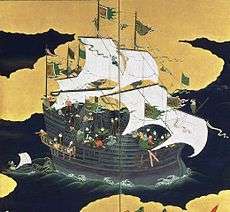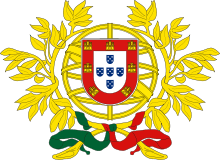Japan–Portugal relations
 |
|
Japan |
Portugal |
|---|---|
Japanese–Portugal relations describes the foreign relations between Japan and Portugal. Although Portuguese sailors visited Japan first in 1543, diplomatic relations started in the nineteenth century.
History
The first affiliation between Portugal and Japan started in 1543, when the Portuguese explorers landed in the southern archipelago of Japan. This period of time is often entitled Nanban trade, where both Europeans and Asians would engage in mercantilism. The Portuguese at this time would found the port of Nagasaki, through the initiative of the Jesuit Gaspar Vilela and the Daimyo lord Ōmura Sumitada, in 1571.
The expansion for commerce extended Portuguese influence in Japan, particularly in Kyushu, where the port became a strategic hot spot, after the Portuguese assistance to Daimyo Sumitada on repelling an attack on the harbor by the Ryūzōji clan in 1578.
The cargo of the first Portuguese ships upon docking in Japan, were basically cargo coming from China (silk, porcelain, etc.). The Japanese craved these goods, which were prohibited from the contacts with the Chinese by the Emperor, as punishment for the attacks of the Wokou piracy. Thus, the Portuguese acted as intermediaries in Asian trade.
In 1592 the Portuguese trade with Japan, started being increasingly challenged by Chinese smugglers on their reeds, in addition to Spanish vessels coming to Manila in 1600, the Dutch in 1609, and English in 1613.
One of the many things that the Japanese were interested in, were Portuguese fire guns. The first three Europeans to arrive in Japan in 1543, were Portuguese traders António Mota, António Peixoto and Francisco Zeimoto (also presumably Fernão Mendes Pinto). They arrived at the southern tip of Tanegashima, where they would introduce firearms to the local population. These muskets would later receive the name after its location.
Because Japan was in the midst of a civil war, called the Sengoku period, the Japanese holstered Portuguese guns of a lighter and better mechanism, with an accurate aim. The Famous Daimyo who virtually unified Japan, Oda Nobunaga, made extensive use of guns ( arquebus ) playing a key role in the Battle of Nagashino. Within a year, Japanese smiths were able to reproduce the mechanism and began to mass-produce the Portuguese arms. And just 50 years later, his armies were equipped with a number of weapons perhaps greater than any contemporary army in Europe. The weapons were extremely important in the unification of Japan under Toyotomi Hideyoshi and Tokugawa Ieyasu, as well as in the invasion of Korea in 1592 and 1597. Europeans brought by trade not only weapons, but also soap, tobacco, and other unknown products in Feudal Japan.
After the Portuguese first made contact with Japan in 1543, a large scale slave trade developed in which Portuguese purchased Japanese as slaves in Japan and sold them to various locations overseas, including Portugal itself, throughout the sixteenth and seventeenth centuries.[1][2] Many documents mention the large slave trade along with protests against the enslavement of Japanese. Japanese slaves are believed to be the first of their nation to end up in Europe, and the Portuguese purchased large amounts of Japanese slave girls to bring to Portugal for sexual purposes, as noted by the Church in 1555. King Sebastian feared that it was having a negative effect on Catholic proselytization since the slave trade in Japanese was growing to massive proportions, so he commanded that it be banned in 1571[3][4]
Japanese slave women were even sold as concubines, serving on Portuguese ships and trading in Japan, mentioned by Luis Cerqueira, a Portuguese Jesuit, in a 1598 document.[5] Japanese slaves were brought by the Portuguese to Macau, where some of them not only ended up being enslaved to Portuguese, but as slaves to other slaves, with the Portuguese owning Malay and African slaves, who in turn owned Japanese slaves of their own.[6][7]
Hideyoshi was so disgusted that his own Japanese people were being sold en masse into slavery on Kyushu, that he wrote a letter to Jesuit Vice-Provincial Gaspar Coelho on 24 July 1587 to demand the Portuguese, Siamese (Thai), and Cambodians stop purchasing and enslaving Japanese and return Japanese slaves who ended up as far as India.[8][9][10] Hideyoshi blamed the Portuguese and Jesuits for this slave trade and banned Christian proselytizing as a result.[11][12]
Some Korean slaves were bought by the Portuguese and brought back to Portugal from Japan, where they had been among the tens of thousands of Korean prisoners of war transported to Japan during the Japanese invasions of Korea (1592–98).[13][14] Historians pointed out that at the same time Hideyoshi expressed his indignation and outrage at the Portuguese trade in Japanese slaves, he himself was engaging in a mass slave trade of Korean prisoners of war in Japan.[15][16]
Fillippo Sassetti saw some Chinese and Japanese slaves in Lisbon among the large slave community in 1578.[17][18][19][20][21]
The Portuguese "highly regarded" Asian slaves like Chinese and Japanese, much more "than slaves from sub-Saharan Africa".[22][23] The Portuguese attributed qualities like intelligence and industriousness to Chinese and Japanese slaves which is why they favored them more.[24][25][26][27]
In 1595 a law was passed by Portugal banning the selling and buying of Chinese and Japanese slaves.[28]
Language
As a result of the Portuguese arrival to Japan, after a continuous influx of trade between Asia and Europe, Japanese vocabulary absorbed words of Portuguese origin as well as Portuguese of Japanese. Among its great part, these words mainly refer to products and customs that arrived through Portuguese traders.
Portuguese was the first occidental language to have a Japanese dictionary, the Nippo Jisho (日葡辞書, Nippojisho) dictionary or "Vocabvlário da Lingoa de Iapam" ("Vocabulary of the Language of Japan" in old-fashioned orthography), compiled by Jesuits such as João Rodrigues, published in Nagasaki in 1603.
See also
- Arte da Lingoa de Iapam
- Christianity in Japan
- Hidden Christians of Japan
- History of Roman Catholicism in Japan
- A Ilha dos Amores
- List of Japanese words of Portuguese origin
- Medical School of Japan
- Nanban trade
- Nippo Jisho
- Tanegashima (Japanese matchlock)
References
- ↑ HOFFMAN, MICHAEL (May 26, 2013). "The rarely, if ever, told story of Japanese sold as slaves by Portuguese traders". The Japan Times. Retrieved 2014-03-02.
- ↑ "Europeans had Japanese slaves, in case you didn't know…". Japan Probe. May 10, 2007. Retrieved 2014-03-02.
- ↑ Nelson, Thomas (Winter 2004). "Monumenta Nipponica (Slavery in Medieval Japan)". Sophia University. p. 463. JSTOR 25066328.
- ↑ Monumenta Nipponica: Studies on Japanese Culture, Past and Present, Volume 59, Issues 3-4. Jōchi Daigaku. Sophia University. 2004. p. 463. Retrieved 2014-02-02.
- ↑ Michael Weiner, ed. (2004). Race, Ethnicity and Migration in Modern Japan: Imagined and imaginary minorites (illustrated ed.). Taylor & Francis. p. 408. ISBN 0415208572. Retrieved 2014-02-02.
- ↑ Kwame Anthony Appiah, Henry Louis Gates, Jr., eds. (2005). Africana: The Encyclopedia of the African and African American Experience (illustrated ed.). Oxford University Press. p. 479. ISBN 0195170555. Retrieved 2014-02-02.
- ↑ Anthony Appiah, Henry Louis Gates, eds. (2010). Encyclopedia of Africa, Volume 1 (illustrated ed.). Oxford University Press. p. 187. ISBN 0195337700. Retrieved 2014-02-02.
- ↑ Monumenta Nipponica. Jōchi Daigaku. Sophia University. 2004. p. 465. Retrieved 2014-02-02.
- ↑ Joseph Mitsuo Kitagawa (2013). Religion in Japanese History (illustrated, reprint ed.). Columbia University Press. p. 144. ISBN 023151509X. Retrieved 2014-02-02.
- ↑ Donald Calman (2013). Nature and Origins of Japanese Imperialism. Routledge. p. 37. ISBN 1134918437. Retrieved 2014-02-02.
- ↑ Gopal Kshetry (2008). FOREIGNERS IN JAPAN: A Historical Perspective. Xlibris Corporation. ISBN 1469102447. Retrieved 2014-02-02.
- ↑ J F Moran, J. F. Moran (2012). Japanese and the Jesuits. Routledge. ISBN 1134881126. Retrieved 2014-02-02.
- ↑ Robert Gellately, Ben Kiernan, eds. (2003). The Specter of Genocide: Mass Murder in Historical Perspective (reprint ed.). Cambridge University Press. p. 277. ISBN 0521527503. Retrieved 2014-02-02.
- ↑ Gavan McCormack (2001). Reflections on Modern Japanese History in the Context of the Concept of "genocide". Edwin O. Reischauer Institute of Japanese Studies. Harvard University, Edwin O. Reischauer Institute of Japanese Studies. p. 18. Retrieved 2014-02-02.
- ↑ Olof G. Lidin (2002). Tanegashima - The Arrival of Europe in Japan. Routledge. p. 170. ISBN 1135788715. Retrieved 2014-02-02.
- ↑ Amy Stanley (2012). Selling Women: Prostitution, Markets, and the Household in Early Modern Japan. Volume 21 of Asia: Local Studies / Global Themes. Matthew H. Sommer. University of California Press. ISBN 0520952383. Retrieved 2014-02-02.
- ↑ Jonathan D. Spence (1985). The memory palace of Matteo Ricci (illustrated, reprint ed.). Penguin Books. p. 208. ISBN 0140080988. Retrieved 2012-05-05.
countryside.16 Slaves were everywhere in Lisbon, according to the Florentine merchant Filippo Sassetti, who was also living in the city during 1578. Black slaves were the most numerous, but there were also a scattering of Chinese
- ↑ José Roberto Teixeira Leite (1999). A China no Brasil: influências, marcas, ecos e sobrevivências chinesas na sociedade e na arte brasileiras (in Portuguese). UNICAMP. Universidade Estadual de Campinas. p. 19. ISBN 8526804367. Retrieved 2012-05-05.
Idéias e costumes da China podem ter-nos chegado também através de escravos chineses, de uns poucos dos quais sabe-se da presença no Brasil de começos do Setecentos.17 Mas não deve ter sido através desses raros infelizes que a influência chinesa nos atingiu, mesmo porque escravos chineses (e também japoneses) já existiam aos montes em Lisboa por volta de 1578, quando Filippo Sassetti visitou a cidade,18 apenas suplantados em número pelos africanos. Parece aliás que aos últimos cabia o trabalho pesado, ficando reservadas aos chins tarefas e funções mais amenas, inclusive a de em certos casos secretariar autoridades civis, religiosas e militares.
- ↑ Jeanette Pinto (1992). Slavery in Portuguese India, 1510-1842. Himalaya Pub. House. p. 18. Retrieved 2012-05-05.
ing Chinese as slaves, since they are found to be very loyal, intelligent and hard working' . . . their culinary bent was also evidently appreciated. The Florentine traveller Fillippo Sassetti, recording his impressions of Lisbon's enormous slave population circa 1580, states that the majority of the Chinese there were employed as cooks.
- ↑ Charles Ralph Boxer (1968). Fidalgos in the Far East 1550-1770 (2, illustrated, reprint ed.). 2, illustrated, reprint. p. 225. Retrieved 2012-05-05.
be very loyal, intelligent, and hard-working. Their culinary bent (not for nothing is Chinese cooking regarded as the Asiatic equivalent to French cooking in Europe) was evidently appreciated. The Florentine traveller Filipe Sassetti recording his impressions of Lisbon's enormous slave population circa 1580, states that the majority of the Chinese there were employed as cooks. Dr. John Fryer, who gives us an interesting ...
- ↑ José Roberto Teixeira Leite (1999). A China No Brasil: Influencias, Marcas, Ecos E Sobrevivencias Chinesas Na Sociedade E Na Arte Brasileiras (in Portuguese). UNICAMP. Universidade Estadual de Campinas. p. 19. ISBN 8526804367. Retrieved 2014-02-02.
- ↑ Paul Finkelman (1998). Paul Finkelman, Joseph Calder Miller, ed. Macmillan encyclopedia of world slavery, Volume 2. Macmillan Reference USA, Simon & Schuster Macmillan. p. 737. ISBN 0028647815. Retrieved 2014-02-02.
- ↑ Finkelman & Miller 1998, p. 737
- ↑ Duarte de Sande (2012). Derek Massarella, ed. Japanese Travellers in Sixteenth-century Europe: A Dialogue Concerning the Mission of the Japanese Ambassadors to the Roman Curia (1590). Volume 25 of 3: Works, Hakluyt Society Hakluyt Society. Ashgate Publishing, Ltd. ISBN 140947223X. ISSN 0072-9396. Retrieved 2014-02-02.
- ↑ A. C. de C. M. Saunders (1982). A Social History of Black Slaves and Freedmen in Portugal, 1441-1555. Volume 25 of 3: Works, Hakluyt Society Hakluyt Society (illustrated ed.). Cambridge University Press. p. 168. ISBN 0521231507. Retrieved 2014-02-02.
- ↑ Jeanette Pinto (1992). Slavery in Portuguese India, 1510-1842. Himalaya Pub. House. p. 18. Retrieved 2014-02-02.
- ↑ Charles Ralph Boxer (1968). Fidalgos in the Far East 1550-1770 (2, illustrated, reprint ed.). Oxford U.P. p. 225. Retrieved 2014-02-02.
- ↑ Dias 2007, p. 71
- Dias, Maria Suzette Fernandes (2007), Legacies of slavery: comparative perspectives, Cambridge Scholars Publishing, p. 238, ISBN 1-84718-111-2


